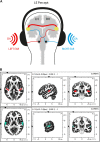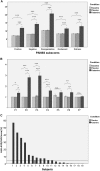Alterations in interhemispheric gamma-band connectivity are related to the emergence of auditory verbal hallucinations in healthy subjects during NMDA-receptor blockade
- PMID: 29453445
- PMCID: PMC5983549
- DOI: 10.1038/s41386-018-0014-z
Alterations in interhemispheric gamma-band connectivity are related to the emergence of auditory verbal hallucinations in healthy subjects during NMDA-receptor blockade
Abstract
Auditory verbal hallucinations (AVH) are a common positive symptom of schizophrenia. Excitatory-to-inhibitory (E/I) imbalance related to disturbed N-methyl-D-aspartate receptor (NMDAR) functioning has been suggested as a possible mechanism underlying altered connectivity and AVH in schizophrenia. The current study examined the effects of ketamine, a NMDAR antagonist, on glutamate-related mechanisms underlying interhemispheric gamma-band connectivity, conscious auditory perception during dichotic listening (DL), and the emergence of auditory verbal distortions and hallucinations (AVD/AVH) in healthy volunteers. In a single-blind, pseudo-randomized, placebo-controlled crossover design, nineteen male, right-handed volunteers were measured using 64 channel electroencephalography (EEG). Psychopathology was assessed with the PANSS interview and the 5D-ASC questionnaire, including a subscale to detect auditory alterations with regard to AVD/AVH (AUA-AVD/AVH). Interhemispheric connectivity analysis was performed using eLORETA source estimation and lagged phase synchronization (LPS) in the gamma-band range (30-100 Hz). Ketamine induced positive symptoms such as hallucinations in a subgroup of healthy subjects. In addition, interhemispheric gamma-band connectivity was found to be altered under ketamine compared to placebo, and subjects with AUA-AVD/AVH under ketamine showed significantly higher interhemispheric gamma-band connectivity than subjects without AUA-AVD/AVH. These findings demonstrate a relationship between NMDAR functioning, interhemispheric connectivity in the gamma-band frequency range between bilateral auditory cortices and the emergence of AVD/AVH in healthy subjects. The result is in accordance with the interhemispheric miscommunication hypothesis of AVH and argues for a possible role of glutamate in AVH in schizophrenia.
Conflict of interest statement
The authors declare that they have no conflict of interest.
Figures




Similar articles
-
Auditory verbal hallucinations related to altered long-range synchrony of gamma-band oscillations.Sci Rep. 2017 Aug 21;7(1):8401. doi: 10.1038/s41598-017-09253-7. Sci Rep. 2017. PMID: 28827744 Free PMC article.
-
The interhemispheric miscommunication theory of auditory verbal hallucinations in schizophrenia.Int J Psychophysiol. 2019 Nov;145:83-90. doi: 10.1016/j.ijpsycho.2019.02.002. Epub 2019 Feb 7. Int J Psychophysiol. 2019. PMID: 30738815 Review.
-
Ketamine Alters Functional Gamma and Theta Resting-State Connectivity in Healthy Humans: Implications for Schizophrenia Treatment Targeting the Glutamate System.Front Psychiatry. 2021 Jun 10;12:671007. doi: 10.3389/fpsyt.2021.671007. eCollection 2021. Front Psychiatry. 2021. PMID: 34177660 Free PMC article.
-
The role of functional and structural interhemispheric auditory connectivity for language lateralization - A combined EEG and DTI study.Sci Rep. 2018 Oct 18;8(1):15428. doi: 10.1038/s41598-018-33586-6. Sci Rep. 2018. PMID: 30337548 Free PMC article.
-
Interhemispheric auditory connectivity: structure and function related to auditory verbal hallucinations.Front Hum Neurosci. 2014 Feb 11;8:55. doi: 10.3389/fnhum.2014.00055. eCollection 2014. Front Hum Neurosci. 2014. PMID: 24574995 Free PMC article. Review.
Cited by
-
Reduced auditory evoked gamma-band response and schizophrenia-like clinical symptoms under subanesthetic ketamine.Neuropsychopharmacology. 2019 Jun;44(7):1239-1246. doi: 10.1038/s41386-019-0328-5. Epub 2019 Feb 6. Neuropsychopharmacology. 2019. PMID: 30758327 Free PMC article. Clinical Trial.
-
Exploring concomitant neuroimaging and genetic alterations in patients with and patients without auditory verbal hallucinations: A pilot study and mini review.J Int Med Res. 2020 Jul;48(7):300060519884856. doi: 10.1177/0300060519884856. J Int Med Res. 2020. PMID: 32696690 Free PMC article. Review.
-
Neurochemistry of Visual Attention.Front Neurosci. 2021 May 5;15:643597. doi: 10.3389/fnins.2021.643597. eCollection 2021. Front Neurosci. 2021. PMID: 34025339 Free PMC article. Review.
-
Glutamatergic Deficits in Schizophrenia - Biomarkers and Pharmacological Interventions within the Ketamine Model.Curr Pharm Biotechnol. 2018;19(4):293-307. doi: 10.2174/1389201019666180620112528. Curr Pharm Biotechnol. 2018. PMID: 29929462 Free PMC article. Review.
-
Glutamatergic mechanisms in early salience processing.Front Pharmacol. 2025 Jul 1;16:1601797. doi: 10.3389/fphar.2025.1601797. eCollection 2025. Front Pharmacol. 2025. PMID: 40667504 Free PMC article.
References
Publication types
MeSH terms
Substances
LinkOut - more resources
Full Text Sources
Other Literature Sources
Miscellaneous

